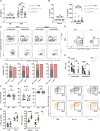A TNF-IL-1 circuit controls Yersinia within intestinal pyogranulomas
- PMID: 38363547
- PMCID: PMC10873131
- DOI: 10.1084/jem.20230679
A TNF-IL-1 circuit controls Yersinia within intestinal pyogranulomas
Abstract
Tumor necrosis factor (TNF) is a pleiotropic inflammatory cytokine that mediates antimicrobial defense and granuloma formation in response to infection by numerous pathogens. We previously reported that Yersinia pseudotuberculosis colonizes the intestinal mucosa and induces the recruitment of neutrophils and inflammatory monocytes into organized immune structures termed pyogranulomas (PG) that control Yersinia infection. Inflammatory monocytes are essential for the control and clearance of Yersinia within intestinal PG, but how monocytes mediate Yersinia restriction is poorly understood. Here, we demonstrate that TNF signaling in monocytes is required for bacterial containment following enteric Yersinia infection. We further show that monocyte-intrinsic TNFR1 signaling drives the production of monocyte-derived interleukin-1 (IL-1), which signals through IL-1 receptors on non-hematopoietic cells to enable PG-mediated control of intestinal Yersinia infection. Altogether, our work reveals a monocyte-intrinsic TNF-IL-1 collaborative inflammatory circuit that restricts intestinal Yersinia infection.
© 2024 Matsuda et al.
Conflict of interest statement
Disclosures: The authors declare no competing interests exist.
Figures











Update of
-
A TNF-IL-1 circuit controls Yersinia within intestinal granulomas.bioRxiv [Preprint]. 2023 Apr 22:2023.04.21.537749. doi: 10.1101/2023.04.21.537749. bioRxiv. 2023. Update in: J Exp Med. 2024 Mar 4;221(3):e20230679. doi: 10.1084/jem.20230679. PMID: 37197029 Free PMC article. Updated. Preprint.
References
MeSH terms
Substances
Grants and funding
- F32 AI164655/AI/NIAID NIH HHS/United States
- R01 DK123528/DK/NIDDK NIH HHS/United States
- R21 AI151476/AI/NIAID NIH HHS/United States
- S10 OD023465/OD/NIH HHS/United States
- R21 AI105346/AI/NIAID NIH HHS/United States
- R01 AI128530/AI/NIAID NIH HHS/United States
- P30 CA016520/CA/NCI NIH HHS/United States
- R01 AI118861/AI/NIAID NIH HHS/United States
- R01 AI139102/AI/NIAID NIH HHS/United States
- F31 AI160741/AI/NIAID NIH HHS/United States
- R01 AI123243/AI/NIAID NIH HHS/United States
- R21 AI163596/AI/NIAID NIH HHS/United States
- F31 AI161319/AI/NIAID NIH HHS/United States
- T32 AI141393/AI/NIAID NIH HHS/United States
- R01AI128530/NH/NIH HHS/United States
LinkOut - more resources
Full Text Sources
Molecular Biology Databases

